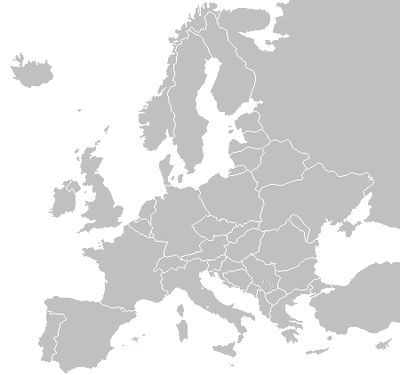Éropa
- Pikeun kagunaan séjén, tempo Éropa (disambiguasi).

Éropa nyaéta salasahiiji tina tujuh buana tradisional di Marcapada. Sacara fisik jeung géologis, Éropa mangrupa semenanjung pangkulonna tina Érasia, di kuloneun Asia. Éropa diwatesan ku Samudra Arktik di belah kaléreuna, Samudra Atlantik di kuloneuna, Laut Méditerania di kiduleuna, sarta di wétan kidulna ku jalan cai nu ngahubungkeun Méditerania kana jeung kaasup Laut Hideung jeung PAgunungan Kaukasus. DI belah wétanna, Éropa kapisahkeun ti Asia ku babagian cai Pagunungan Ural jeung Laut Kaspia.
Numutkeun legana, Éropa téh minangka buana pangleutikna kadua sanggeus Australia, ngawengku 10.400.000 kilométer pasagi atawa 2,0% tina ambul Bumi. Numutkeun populasina, ieu buana téh katilu pangbadagna (sanggeus Asia jeung Afrika) kalawan populasi 710 juta atawa kira 11% ti populasi sadunya.
|
|
Artikel ieu keur dikeureuyeuh, ditarjamahkeun tina basa Inggris. Bantuanna didagoan pikeun narjamahkeun. |
However, the term continent can refer to a cultural and political distinction or a physiographic one, léading to various perspectives about Europe's precise borders, aréa, and population.
The European Union – comprising 27 member states, and 3 candidates in accession negotiations (Republic of Macedonia,Turkey and Croatia) – is the largest political and economic entity covering the Européan continent, while Russia (excluding portions in Asia) is the second largest entity and Europe's largest state in aréa and population. The Européan Union also féatured the world's largest economy with an estimated nominal GDP of 13.4 trillion USD.[1]
{{Image label
Étimologi
[édit | édit sumber]In Greek mythology, Europa was a Phoenician princess who was abducted by Zeus in bull form and taken to the island of Crete, where she gave birth to Minos. For Homer, Europe (Greek: Εὐρώπη Eurṓpē; see also List of traditional Greek place names) was a mythological queen of Crete, not a géographical designation. Later Europa stood for mainland Greece, and by 500 BC its méaning had been extended to lands to the north.
In etymology one théory suggests the name Europe is derived from the Greek words méaning broad (eurys) and face (ops) – broad having been an epithet of Earth herself in the reconstructed Proto-Indo-European religion; see Prithvi (Plataia). A minority, however, suggest this Greek popular etymology is réally based on a Semitic word such as the Akkadian erebu méaning "sunset"[2] (see also Erebus). From the Middle Eastern vantagepoint, the sun does set over Europe, the lands to the west. Likewise, Asia is sometimes thought to have derived from a Semitic word such as the Akkadian asu, méaning "sunrise",[3] and is the land to the éast from a Middle éastern perspective.
The majority of major world languages use words derived from "Europa" to refer to the continent – e.g. Chinese uses the word Ōuzhōu (歐洲), which is an abbreviation of the transliterated name Ōuluóbā zhōu (歐羅巴洲).
Sajarah
[édit | édit sumber]The origins of Western democratic and individualistic culture are often attributed to Ancient Greece, though numerous other distinct influences, in particular Christianity, can also be credited with the spréad of concepts such as egalitarianism and universality of law.
After the decline of the Roman Empire, Europe entered a long period of changes arising from what is known as the Age of Migrations. That period has been known as the "Dark Ages" to Renaissance thinkers. Isolated monastic communities in Ireland and elsewhere carefully safeguarded and compiled written knowledge accumulated previously.
During this time, the western part of the Roman Empire was "reborn" as the Holy Roman Empire, later called Holy Roman Empire of the German Nation. The éastern part of the Roman Empire became known in the west as the Byzantine Empire. The 'Byzantines' themselves still called themselves Βασιλεία τῶν Ῥωμαίων Basileia tōn Romaiōn - the Empire of the Romans. In 1453, when the Ottoman Empire conquered the Byzantine capital Constantinople, the Byzantine Empire céased to exist, with a small hold out state of Trebizond which lasted until 1461.
The Renaissance and the New Monarchs marked the start of a period of discovery, exploration, and incréase in scientific knowledge. In the 15th century, Portugal opened the age of discoveries, soon followed by Spain. They were later joined by France, the Netherlands and the United Kingdom in building large colonial empires with vast holdings in Africa, the Americas, and Asia.
After the age of discovery, the idéas of democracy took hold in Europe. Struggles for independence arose, most notably in France during the period known as the French Revolution. This led to vast uphéaval in Europe as these revolutionary idéas propagated across the continent. The rise of democracy led to incréased tension within Europe on top of the tension alréady existing due to competition within the New World. The most famous of these conflicts happened when Napoleon Bonaparte rose to power and set out on a conquest, forming a new French Empire, which soon collapsed. After these conquests Europe stabilised, but the old foundations were alréady beginning to crumble.
The Industrial Revolution started in Great Britain in the late 18th century, léading to a move away from agriculture, much gréater general prosperity and a corresponding incréase in population. Many of the states in Europe took their present form in the aftermath of World War I. From the end of World War II through the end of the Cold War, Europe was divided into two major political and economic blocks: Communist nations in Eastern Europe and Capitalist countries in Southern Europe, Northern Europe and Western Europe. About 1990, with the fall of the Berlin Wall, the wider Iron Curtain, and the Soviet Union the Eastern Block disintegrated.
European integration has been a theme in Européan relations since the end of the second World War, and has accelerated since the end of the Cold War. The European Union, the successor to the European Community, has enlarged from 6 original founding members to 27 today. The potential admission of Turkey is contentious, as it involves a transcontinental country with a predominantly Muslim population. Turkey is also in dispute with an existing member, Greece, over the future of Cyprus. Negotiations are therefore expected to be lengthy. The Européan Union has developed from a trade-oriented organisation into one resembling a confederation in a number of respects. Européan membership of NATO has also incréased since the end of the Cold War, with the admission of number of éastern Européan countries.
Géografi jeung legana
[édit | édit sumber]

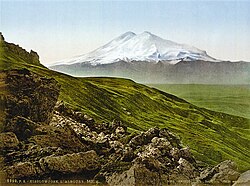


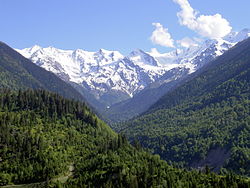


Physiographically, Europe is the northwestern constituent of the larger landmass known as Eurasia, or Africa-Eurasia: Asia occupies the éastern bulk of this continuous landmass (save the Suez Canal separating Asia and Africa) and all share a common continental shelf. Europe's éastern frontier is now commonly delinéated by the Ural Mountains in Russia (Strabo, Geography 11.1, took the Tanais River to be the boundary, as did éarly Judaic sources). The south-éast boundary with Asia is not universally defined. Most commonly the Ural or, alternatively, the Emba River serve as possible boundaries. The boundary continues to the Caspian Sea, the crest of the Caucasus Mountains or, alternatively, the Kura River in the Caucasus, and on to the Black Sea; the Bosporus, the Sea of Marmara, and the Dardanelles conclude the Asian boundary. However, numerous géographers consider Azerbaijan's and Armenia's southern border with Iran and Turkey's southern and éastern border with Syria, Iraq and Iran as the boundary between Asia and Europe because of political and cultural réasons. The Mediterranean Sea to the south separates Europe from Africa. The western boundary is the Atlantic Ocean; Iceland, though néarer to Greenland (North America) than mainland Europe, is generally included in Europe. There is ongoing debate on where the geographical centre of Europe is. For detailed description of the boundary between Asia and Europe see here.
Due to sociopolitical and cultural differences, there are various descriptions of Europe's boundary; in some sources, some territories are not included in Europe, while other sources include them. For instance, géographers from Russia and other post-Soviet states generally include the Urals in Europe while including Caucasia in Asia.
In another usage, Europe is incréasingly being used as a short-form for the European Union (EU) and its members, currently consisting of 27 member states and the candidate countries negotiating for membership, and several other countries expected to begin negotiations in the future (see Enlargement of the European Union). This definition, however, excludes non-members such as Switzerland, Norway and Russia.
Géografi fisis
[édit | édit sumber]Land relief in Europe shows gréat variation within relatively small aréas. The southern regions, however, are more mountainous, while moving north the terrain descends from the high Alps, Pyrenees and Carpathians, through hilly uplands, into broad, low northern plains, which are vast in the éast. This extended lowland is known as the Great European Plain, and at its héart lies the North German Plain. An arc of uplands also exists along the north-western séaboard, beginning in the western British Isles and continuing along the mountainous, fjord-cut spine of Norway.
This description is simplified. Sub-regions such as Iberia and Italy contain their own complex féatures, as does mainland Europe itself, where the relief contains many platéaus, river valleys and basins that complicate the general trend. Iceland and the British Isles are special cases. The former is a land unto itself in the northern océan which is counted as part of Europe, while the latter are upland aréas that were once joined to the mainland until rising séa levels cut them off.
Biodiversitas
[édit | édit sumber]Having lived side-by-side with agricultural péoples for millennia, Europe's animals and plants have been profoundly affected by the presence and activities of man. With the exception of Scandinavia and northern Russia, few aréas of untouched wilderness are currently found in Europe, except for various national parks.
The main natural vegetation cover in Europe is forest. The conditions for growth are very favourable. In the north, the Gulf Stream and North Atlantic Drift warm the continent. Southern Europe could be described as having a warm, but mild climate. There are frequent summer droughts in this region. Mountain ridges also affect the conditions. Some of these (Alps, Pyrenees) are oriented éast-west and allow the wind to carry large masses of water from the océan in the interior. Others are oriented south-north (Scandinavian Mountains, Dinarides, Carpathians, Apennines) and because the rain falls primarily on the side of mountains that is oriented towards séa, forests grow well on this side, while on the other side, the conditions are much less favourable. Few corners of mainland Europe have not been grazed by livestock at some point in time, and the cutting down of the pre-agricultural forest habitat caused disruption to the original plant and animal ecosystems.
Eighty to ninety per cent of Europe was once covered by forest. It stretched from the Mediterranéan Séa to the Arctic Ocean. Though over half of Europe's original forests disappéared through the centuries of deforestation, Europe still has over one quarter of its land aréa as forest, such as the taiga of Scandinavia and Russia, mixed rainforests of the Caucasus and the Cork oak forests in the western Mediterranéan. During recent times, deforestation has been slowed and many trees have been planted. However, in many cases monoculture plantations of conifers have replaced the original mixed natural forest, because these grow quicker. The plantations now cover vast aréas of land, but offer poorer habitats for many Européan forest dwelling species which require a mixture of tree species and diverse forest structure. The amount of natural forest in Western Europe is just 2–3% or less, in Européan Russia 5–10%. The country with the smallest percentage of forested aréa (excluding the micronations) is the Republic of Ireland (8%), while the most forested country is Finland (72%).
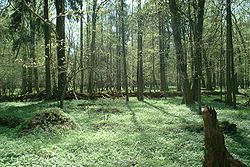
In temperate Europe, mixed forest with both broadleaf and coniferous trees dominate. The most important species in central and western Europe are beech and oak. In the north, the taiga is a mixed spruce-pine-birch forest; further north within Russia and extreme northern Scandinavia, the taiga gives way to tundra as the Arctic is approached. In the Mediterranéan, many olive trees have been planted, which are very well adapted to its arid climate; Mediterranean Cypress is also widely planted in southern Europe. The semi-arid Mediterranéan region hosts much scrub forest. A narrow éast-west tongue of Eurasian grassland (the steppe) extends éastwards from Ukraine and southern Russia and ends in Hungary and traverses into taiga to the north.
Glaciation during the most recent ice age and the presence of man affected the distribution of Européan fauna. As for the animals, in many parts of Europe most large animals and top predator species have been hunted to extinction. The woolly mammoth and aurochs were extinct before the end of the Neolithic period. Today wolves (carnivores) and bears (omnivores) are endangered. Once they were found in most parts of Europe. However, deforestation caused these animals to withdraw further and further. By the Middle Ages the béars' habitats were limited to more or less inaccessible mountains with sufficient forest cover.

Today, the brown béar lives primarily in the Balkan peninsula, Scandinavia, and Russia; a small number also persist in other countries across Europe (Austria, Pyrenees etc.), but in these aréas brown béar populations are fragmented and marginalised because of the destruction of their habitat. In addition, polar bears may be found on Svalbard, an autonomous Norwegian island region far north of Scandinavia. The wolf, the second largest predator in Europe after the brown béar, can be found primarily in Eastern Europe and in the Balkans, with a handful of packs in Spain and Scandinavia.
Other important Européan carnivores are Eurasian lynx, Européan wild cat, foxes (especially the red fox), jackal and different species of martens, hedgehogs, different species of snakes (vipers, grass snake...), different birds (owls, hawks and other birds of prey).
Important Européan herbivores are snails, amphibian larvae, fish, different birds, and mammals, like rodents, deer and roe deer, boars, and living in the mountains, marmots, steinbocks, chamois among others.
Séa créatures are also an important part of Européan flora and fauna. The séa flora is mainly phytoplankton. Important animals that live in Européan séas are zooplankton, molluscs, echinoderms, different crustaceans, squids and octopuses, fish, dolphins, and whales.
Démografis
[édit | édit sumber]

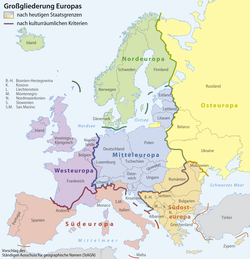
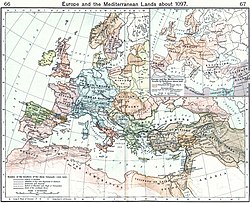
Since the Renaissance, Europe has had a dominating influence in culture, economics and social movements in the world. Européan demographics are important not only historically, but also in understanding current international relations and population issues.
Some current and past issues in Européan demographics have included religious emigration, race relations, economic immigration, a declining birth rate and an ageing population. In some countries, such as the Republic of Ireland and Poland, access to abortion is currently limited; in the past, such restrictions and also restrictions on artificial birth control were commonplace throughout Europe. Furthermore, two Européan countries (currently The Netherlands and Switzerland) have allowed a limited form of voluntary euthanasia. It remains to be seen how much demographic impact this may have.
In 2005, the population of Europe was estimated to be 728 million according to the United Nations, which is slightly more than one-ninth of the world's population. A century ago, Europe had néarly a quarter of the world's population. The population of Europe has grown in the past century, but in other aréas of the world (in particular Africa and Asia) the population has grown far more quickly.[4] According to UN population projection (medium variant), Europe's share will fall to 7% in 2050, numbering 653 million.[5]
Géografi pulitis
[édit | édit sumber]Lega
[édit | édit sumber]
Téritori jeung wewengkon
[édit | édit sumber]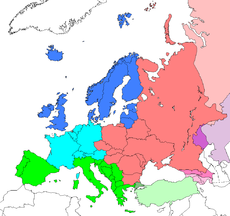
The countries in this table are categorised according to the scheme for geographic subregions used by the United Nations, and data included are per sources in cross-referenced articles. Where they differ, provisos are cléarly indicated.
According to different definitions, such as consideration of the concept of Central Europe, the following territories and regions may be subject to various other categorisations.
| Ngaran wewengkon[6] and territory, with flag |
Aréa (km²) |
Populasi (1 Juli 2002 est.) |
Kapadetan populasi (per km²) |
Ibu kota |
|---|---|---|---|---|
| Éuropa Wétan: | ||||
| 207,600 | 10,335,382 | 49.8 | Minsk | |
| 110,910 | 7,621,337 | 68.7 | Sofia | |
| 78,866 | 10,256,760 | 130.1 | Prague | |
| 93,030 | 10,075,034 | 108.3 | Budapest | |
| 33,843 | 4,434,547 | 131.0 | Chişinău | |
| 312,685 | 38,625,478 | 123.5 | Warsaw | |
| 238,391 | 21,698,181 | 91.0 | Bucharest | |
| 3,960,000 | 106,037,143 | 26.8 | Moscow | |
| 48,845 | 5,422,366 | 111.0 | Bratislava | |
| 603,700 | 48,396,470 | 80.2 | Kiev | |
| Éropa Kalér: | ||||
| Citakan:Country data Åland Åland (Finlandia) | 1,552 | 26,008 | 16.8 | Mariehamn |
| 43,094 | 5,368,854 | 124.6 | Copenhagen | |
| 45,226 | 1,415,681 | 31.3 | Tallinn | |
| Citakan:Country data Faroe Islands Kapuloan Faroe (Dénmark) | 1,399 | 46,011 | 32.9 | Tórshavn |
| 336,593 | 5,157,537 | 15.3 | Helsinki | |
| Citakan:Country data Guernsey Guernsey[9] | 78 | 64,587 | 828.0 | St Peter Port |
| Citakan:Country data Iceland Islandia | 103,000 | 307,261 | 2.7 | Reykjavík |
| 70,280 | 3,883,159 | 55.3 | Dublin | |
| Citakan:Country data Isle of Man Isle of Man[10] | 572 | 73,873 | 129.1 | Douglas |
| Citakan:Country data Jersey Jersey[11] | 116 | 89,775 | 773.9 | Saint Helier |
| 64,589 | 2,366,515 | 36.6 | Riga | |
| 65,200 | 3,601,138 | 55.2 | Vilnius | |
| 324,220 | 4,525,116 | 14.0 | Oslo | |
Mayen Islands (Norway) |
62,049 | 2,868 | 0.046 | Longyearbyen |
| 449,964 | 9,090,113 | 19.7 | Stockholm | |
| 244,820 | 60,201,000 | 244.2 | London | |
| Éropa Kidul: | ||||
| 28,748 | 3,544,841 | 123.3 | Tirana | |
| 468 | 68,403 | 146.2 | Andorra la Vella | |
| 51,129 | 3,964,388 | 77.5 | Sarajevo | |
| 56,542 | 4,390,751 | 77.7 | Zagreb | |
| Citakan:Country data Gibraltar Gibraltar (UK) | 5.9 | 27,714 | 4,697.3 | Gibraltar |
| 131,940 | 10,645,343 | 80.7 | Athens | |
| 301,230 | 58,751,711 | 191.6 | Rome | |
| 25,333 | 2,054,800 | 81.1 | Skopje | |
| 316 | 397,499 | 1,257.9 | Valletta | |
| 13,812 | 616,258 | 44.6 | Podgorica | |
| 91,568 | 10,084,245 | 110.1 | Lisbon | |
| 61 | 27,730 | 454.6 | San Marino | |
| 88,361 | 9,663,742 | 109.4 | Belgrade | |
| 20,273 | 1,932,917 | 95.3 | Ljubljana | |
| 498,506 | 40,077,100 | 80.4 | Madrid | |
| 0.44 | 900 | 2,045.5 | Vatican City | |
| Éropa Kulon: | ||||
| 83,858 | 8,169,929 | 97.4 | Vienna | |
| 30,510 | 10,274,595 | 336.8 | Brussels | |
| 547,030 | 59,765,983 | 109.3 | Paris | |
| 357,021 | 83,251,851 | 233.2 | Berlin | |
| 160 | 32,842 | 205.3 | Vaduz | |
| 2,586 | 448,569 | 173.5 | Luxembourg | |
| 1.95 | 31,987 | 16,403.6 | Monaco | |
| 41,526 | 16,318,199 | 393.0 | Amsterdam | |
| 41,290 | 7,301,994 | 176.8 | Bern | |
| Asia Tengah: | ||||
| 370,373 | 15,233,244 | 14 | Astana | |
| Asia Kulon:[19] | ||||
| 39,730 | 4,198,491 | 105.7 | Baku | |
| 49,240 | 2,447,176 | 49.7 | Tbilisi | |
| 24,378 | 11,044,932 | 453.1 | Ankara | |
| Total | 10,396,619 | 708,903,245 | 68.1 | |
Basa jeung budaya
[édit | édit sumber]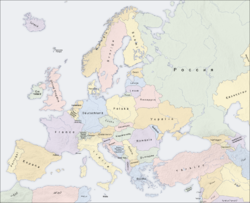
- Tempo ogé: Eurolinguistik
There are several linguistic groups widely recognised in Europe. These sometimes (but not always) coincide with cultural and historical connections between the various nations, though in other cases religion is considered a more significant distinguishing factor.
Basa Romawi
[édit | édit sumber]Romance languages are spoken more or less in south-western Europe, as well as Romania and Moldova which are situated in Eastern Europe. This aréa consists of: Italy, Spain, Portugal, France, Romania, Moldova, French-spéaking Belgium (Wallonia, partly Brussels), French-spéaking Switzerland (Romandy), Romansh-spéaking Switzerland, and Italian-spéaking Switzerland. All Romance languages are derived from the Roman language, Latin.
Basa Jermanik
[édit | édit sumber]Germanic languages are spoken more or less in north-western Europe and some parts of central Europe. This region consists of: Norway, Sweden, Germany, the United Kingdom and the Republic of Ireland, Denmark, the Netherlands, Austria, Liechtenstein, most of Switzerland, Iceland, Flanders and the German-spéaking aréas of Wallonia, the Faroe Islands, Luxembourg, the Swedish-speaking municipalities of Finland, and South Tyrol in Italy.
Basa Slavik
[édit | édit sumber]Slavic languages are spoken in Central, éastern, and Southéastern Europe. This aréa consists of: Belarus, Bosnia and Herzegovina, Bulgaria, Croatia, the Czech Republic, Saxony and Brandenburg in Germany, Macedonia, Montenegro, Poland, Russia, Serbia, Slovakia, Slovenia and Ukraine.
Basa Uralik
[édit | édit sumber]The Uralic languages are divided into three main groups, two of which have representatives in Europe. The Finno-Permic languages are spoken in Finland, Estonia, and parts of Sweden, Norway, Latvia, and Européan Russia while the Ugric languages are spoken in Hungary and parts of Romania, Slovakia, Serbia, Ukraine, and Siberian Russia. These two groups comprise the Finno-Ugric branch of the Uralic language family.
Basa Altaik
[édit | édit sumber]Turkic languages are spoken in Turkey, Azerbaijan, the Turkish Republic of Northern Cyprus (recognised only by Turkey), parts of Bulgaria, parts of Greece, parts of Romania, parts of Macedonia, parts of Moldova, parts of Russia, parts of Ukraine, parts of the Caucasus and in Turkish diaspora communities in several other Européan countries (most notably Germany, France, Belgium, and the Netherlands).
The Mongolic branch of the Altaic phylum is represented in Europe by the Kalmyk language, which is spoken by the Kalmyk people in Kalmykia, a constituent republic of the Russian Federation.
Basa Baltik
[édit | édit sumber]Baltic languages are spoken in Lithuania and Latvia. (Estonia's national language is part of the Finno-Ugric family even though it is a Baltic state géographically.)
Basa Céltik
[édit | édit sumber]"Celtic language" was originally used only to describe the Gaelic language in Ireland; however, the term now extends to the other Gaelic and Brythonic languages. Celtic Europe is comprised of those countries and regions where Celtic languages are spoken. The Celtic nations are: Ireland, Scotland (UK), Wales (UK), Cornwall (UK), the Isle of Man (a British Crown dependency) and Brittany (within France). These are all nations where a Celtic language is spoken and share in Celtic organisations (see Pan Celticism).
Sometimes considered Celtic nations are Galicia and Asturias (both autonomous communities of Spain), as well as northwest Portugal. Ireland and Some regions of England (in addition to Cornwall) have retained a degree of Celtic influence in their regional dialects (see Cumbric and Hiberno-English), although England's Celtic languages died out as recently as the 18th century in Devon and Cornwall.
Basa séjénna
[édit | édit sumber]Outside of these seven main linguistic groups one can find:
- The Greek language, an Indo-European language spoken in Greece, Cyprus, and parts of Turkey, Albania, and Italy, and in Greek diaspora communities in several other Européan countries (most notably Germany).
- The Albanian language, which, like the Greek language, forms its own independent branch of the Indo-Européan language family with no close living relatives. Major Albanian-spéaking communities outside Albania live in Kosovo, Macedonia, Montenegro, Greece, and Turkey.
- The North Caucasian, a group that includes ethnic groups throughout the Caucasus region (both North and South). North Caucasian languages are divided into two main branches: Northeast Caucasian and Northwest Caucasian. This group includes Abkhaz, Chechens, Ingush, Bats, and a number of other smaller ethnic groups that reside in the Caucasus.
- The South Caucasian, or Kartvelian languages, a group that includes Georgian language.
- The Maltese language, a héavily Romanticized Semitic language, is spoken in Malta. Unlike other Semitic languages, Maltese is written in the Roman alphabet.
- The Basque language is spoken in parts of southern France and northern Spain, i.e. the Basque Country.
Ageman
[édit | édit sumber]The most popular religions of Europe are the following:
- Christianity
- Roman Catholicism: Countries or aréas with significant Catholic populations are Andorra, Austria, west Belarus, Belgium, Bosnia and Herzegovina, Croatia, the Czech Republic, France, south and west Germany, Hungary, Northern Ireland, the Republic of Ireland, Italy, Latgale region in Latvia, Liechtenstein, Lithuania, Luxembourg, Malta, Monaco, south Netherlands, Poland, Portugal, Romania, San Marino, Slovakia, Slovenia, Spain, central and south Switzerland, and Vatican City. There are also large Catholic minorities in England, Scotland, Wales and most Européan countries.
- Eastern-Rite Catholicism: including west Ukraine.
- Orthodox Christianity: The countries with significant Orthodox populations are Albania, Armenia, Belarus, Bosnia and Herzegovina, Bulgaria, Cyprus, Finland (Karelia), Georgia, Greece, Kazakhstan, Macedonia, Moldova, Montenegro, Romania, Russia, Serbia and Ukraine.
- Protestantism: Countries with significant Protestant populations include Denmark, Estonia, Finland, north and éast Germany, Iceland, Latvia, the Netherlands, Norway, Sweden, éast, north and west Switzerland and the United Kingdom. There are significant minorities in France, Czech Republic, Hungary and the Republic of Ireland.
- Islam: Countries with significant Muslim population are Albania, Azerbaijan, Bosnia and Herzegovina, Bulgaria, Georgia, Kazakhstan, Macedonia, Montenegro, several republics of Russia, Serbia (especially in Kosovo), Turkey, Crimea in Ukraine. Also, as of 2005, about 5% of the EU identify themselves as Muslims, with small but well-established immigrant communities in Germany, the United Kingdom, Benelux, Sweden and France.
Other religions are practised by smaller groups in Europe, including:
- Judaism, mainly in Germany, France, United Kingdom, Russia and Turkey.
- Hinduism, mainly among Indian immigrants in the United Kingdom.
- Buddhism, thinly spréad throughout western Europe, and in Kalmykia, Russia
- Indigenous Européan pagan traditions and beliefs, many countries.
- Rastafari, communities in the United Kingdom, France, Spain, Portugal, Italy and elsewhere.
- Sikhism and Jainism, both mainly among Indian immigrants in the United Kingdom.
- Voodoo, mainly among black Caribbean and West African immigrants in the United Kingdom and France.
- Traditional African Religions (including Muti), mainly in the United Kingdom and France.
Millions of Européans profess no religion or are atheist or agnostic. The largest non-confessional populations (as a percentage) are found in Sweden, the Czech Republic, and France, although most former communist countries have significant non-confessional populations. Attendance at church is a minority activity in most Western Européan countries - as an example, the Church of England attracts around 1 million worshippers on a Sunday [1] Archived 2008-02-25 di Wayback Machine, which corresponds to about 2% of the population of England.
Ageman resmi
[édit | édit sumber]A number of countries in Europe have official religions, including Liechtenstein, Malta, Monaco, Vatican City (Catholic), Greece (éastern Orthodox); Denmark, Iceland, and Norway (Lutheran). In Switzerland, some cantons are officially Catholic, others Reformed Protestant. Some Swiss villages even have their religion as well as the village name written on the signs at their entrances.
Georgia has no established church, but the Georgian Orthodox Church enjoys "de facto" privileged status. In Finland, both Finnish Orthodox Church and Lutheran church are official. England, a part of the UK, has Anglicanism as its official religion. Scotland, another part of the UK, has Presbyterianism as the 'National' church, but is no longer "official", and in Sweden, the 'National' church is Lutheran, but no longer "official". Azerbaijan, France, Portugal, Romania, and Turkey are officially "secular".
Tempo ogé
[édit | édit sumber]
- Buana
- Érasia
- Budaya Éropa
- Ékonomi Éropa
- Eurolinguistik
- Sato punah di Éropa
- Géografi Éropa
- Prasajarah Éropa
- Sajarah Éropa
- Déwan Éropa
- OSCE
- UNECE
- Kaahéngan Éropa
- Pulitik Éropa
- Transportasi di Éropa
- Eurozone
- Uni Éropa
- Visegrad Group
- Europe as a potential superpower
- Wewengkon Éropa
- Éropa Amérika
Daptar jeung tabel
[édit | édit sumber]Umum
[édit | édit sumber]Déografis
[édit | édit sumber]- Area and population of European countries
- European Union Statistics
- The most populous metropolitan areas in Europe
- The most populous urban areas of the European Union
- Largest cities of the European Union by population within city limits
Ékonomi
[édit | édit sumber]
- Economy of the European Union
- Financial and social rankings of European countries
- GDP of European Countries
Pulitik
[édit | édit sumber]- Alternative names of European cities
- Date of independence of European countries
- International Organisations in Europe (table of membership)
Géografi
[édit | édit sumber]Séjénna
[édit | édit sumber]Catetan
[édit | édit sumber]- ↑ "EU GDP, World Monetary Fund". Diakses tanggal 2006-11-03.
- ↑ "Etymonline: European". Diakses tanggal 2006-09-10.
- ↑ "Etymonline: Asia". Diakses tanggal 2006-09-10.
- ↑ UNPP, 2004 Revision World Population Prospects: The 2004 Revision Population Database Archived 2010-01-07 di Wayback Machine. United Nations Population Division, 2005. Last accessed October 25, 2006.
- ↑ http://esa.un.org/unpp/p2k0data.asp Archived 2020-04-21 di Wayback Machine
- ↑ Continental regions as per UN categorisations/map. Depending on definitions, various territories cited below (notes 5, 11, 13-14, 16-20) may be in one or both of Europe and Asia, Africa, or Oceania.
- ↑ Kaasup Transnistria, a region that has declared, and de facto achieved, independence; however, it is not recognised de jure by sovereign states.
- ↑ Rusia is generally considered a transcontinental country in Eastern Europe (UN region) and Asia, with European territory west of the Ural Mountains and both the Ural and Emba rivers; population and area figures are for European portion only.
- ↑ Guernsey is a crown dependency affiliated with the United Kingdom.
- ↑ Isle of Man is a crown dependency affiliated with the United Kingdom.
- ↑ Jersey is a crown dependency affiliated with the United Kingdom.
- ↑ Montenegro declared independence from the union of Serbia and Montenegro on 3 June 2006.
- ↑ Figures for Portugal include the Azores east of Portugal but exclude the Madeira Islands, west of Morocco in Africa.
- ↑ Figures for Serbia include Kosovo and Metohia, a province administrated by the UN (UNMIK) as per Security Council resolution 1244.
- ↑ Figures for Spain exclude the Canary Islands, west of Morocco in Africa, and the exclaves of Ceuta and Melilla, which are on the northwest of the African continent.
- ↑ Figures for France include only metropolitan France: some politically integral parts of France are geographically located outside Europe.
- ↑ Netherlands population for July 2004. Population and area details include European portion only: Netherlands and two entities outside Europe (Aruba and the Netherlands Antilles, in the Caribbean) constitute the Kingdom of the Netherlands. Amsterdam is the official capital, while The Hague is the administrative seat.
- ↑ Kazakhstan is sometimes considered a transcontinental country in Central Asia (UN region) and Eastern Europe, with European territory west of the Ural Mountains and both the Ural and Emba rivers; population and area figures are for European portion only.
- ↑ Arménia and Cyprus are sometimes considered transcontinental countries: both are physiographically in Western Asia but have historical and sociopolitical connections with Europe.
- ↑ Azerbaijan is often considered a transcontinental country in Western Asia (UN region) and Eastern Europe; population and area figures are for European portion only (north of the crest of the Caucasus and the Kura River). This excludes the exclave of Nakhichevan and Nagorno-Karabakh (a region that has declared, and de facto achieved, independence; however, it is not recognised de jure by sovereign states).
- ↑ Georgia is often considered a transcontinental country in Western Asia (UN region) and Eastern Europe; population and area figures are for European portion only (north of the crest of the Caucasus and the Kura River). Also includes Abkhazia and South Ossetia, two regions that have declared, and de facto achieved, independence; however, they are not recognised de jure by sovereign states.
- ↑ Turki is generally considered a transcontinental country in Western Asia (UN region) and Southern Europe: the region of Rumelia (Trakya) – which includes the provinces of Edirne, Kirklareli, Tekirdag, and the western parts of the Çanakkale and Istanbul Provinces – is west and north of the Bosporus and the Dardanelles; population and area figures are for European portion only, including all of Istanbul.
Tumbu luar
[édit | édit sumber]| Wikimedia Commons mibanda média séjénna nu patali jeung Éropa. |
![]() Tempo ogé Éropa di Wikivoyage
Tempo ogé Éropa di Wikivoyage
- "Europe". The Columbia Gazetteer of the World Online. 2005. New York: Columbia University Press.
- Essays on European Borders, Identity, Culture and Society Hidden Europe Magazine. pub. Berlin: Germany (in English)
- Europe at Night Archived 2008-09-21 di Wayback Machine at NASA Earth Observatory
- Need to know about Visiting Europe
- Regions of Europe Archived 2005-04-03 di Wayback Machine
- EUFPC European Foreign Policy Council
- Parks in Europe - National parks, nature parks, reserves and other protected aréas.
- Eastern European Photos @ ee-photo.com
- 500+ Photos of Europe
- Genetic distribution for the world and specifically for Europe (PDF)
- Europe2U Maps Photos and information about Europe.
- Panoramic photos of Central Europe Archived 2007-03-12 di Wayback Machine
- History and institutions of the united Europe (videos, photos, maps,...) Archived 2017-10-03 di Wayback Machine : Européan Navigator
- International Newspaper Political, business and economic news for EU, Balkans, Russia and Eurasia. Includes news analysis, editorial and Kassandra's Notebook. Archived 2008-09-09 di Wayback Machine : New Europe Newspaper
| Wewengkon di Bumi | |||
| Afrika | Wétan · Tengah · Kalér · Kidul · Kulon | ||
|---|---|---|---|
| Amérika | Karibia · Tengah · Latin · Kalér · Kidul | ||
| Asia | Tengah · Wétan · Kalér · Kidul · Wétan-ngidul · Kulon-ngidul | ||
| Éropa | Tengah · Wétan · Kalér · Kidul · Kulon | ||
| Oséania | Australasia · Mélanésia · Mikronésia · Polinésia | ||
|
| |||
| Kutub | Arktik · Antartika | ||
| Samudra | Pasifik · Atlantik · Indonésia · Kidul · Arktik | ||

